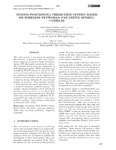Mostrar o rexistro simple do ítem
Indoor Positioning Prediction System Based on Wireless Networks and Depth Sensing Cameras
| dc.contributor.author | Duque Domingo, Jaime | |
| dc.contributor.author | Cerrada, Carlos | |
| dc.contributor.author | Valero, Enrique | |
| dc.date.accessioned | 2022-02-08T13:07:44Z | |
| dc.date.available | 2022-02-08T13:07:44Z | |
| dc.date.issued | 2016 | |
| dc.identifier.citation | Duque Domingo, J., Cerrada, C., Valero, E. Indoor positioning prediction system based on wireless networks and depth sensing cameras. En Actas de las XXXVII Jornadas de Automática. 7, 8 y 9 de septiembre de 2016, Madrid (pp. 1237-1242). DOI capítulo: https://doi.org/10.17979/spudc.9788497498081.1237 DOI libro: https://doi.org/10.17979/spudc.9788497498081 | es_ES |
| dc.identifier.isbn | 978-84-617-4298-1 (UCM) | |
| dc.identifier.isbn | 978-84-9749-808-1 (UDC electrónico) | |
| dc.identifier.uri | http://hdl.handle.net/2183/29728 | |
| dc.description.abstract | [Abstract] This work presents a new system for predicting the movement of people in indoor user environments, based on an advanced Indoor Positioning System (IPS) developed previously by the authors. The mentioned IPS proposes the combination of WiFi Positioning System (WPS) and depth maps provided by RGB-D cameras to improve the efficiency of existing methods, based uniquely on wireless positioning techniques. In this approach, the prediction of movements is carried out by means of a proactive strategy, delivering the next estimated position of the person. This estimation provides a richer location and context information, which is useful for ubiquitous computing purposes. For example, energy consumption can be optimized if lighting or electronic devices are turned on/off by means of the user trajectory prediction. This paper shows how several techniques, applied for the developed IPS, offer different solutions to the indoor prediction problem, and it discusses about which of them gives better results | es_ES |
| dc.description.sponsorship | This work has been developed with the help of the research project DPI2013-44776-R of MICINN. It also belongs to the activities carried out within the framework of the research network CAM RoboCity2030 S2013/MIT-2748 of Comunidad de Madrid | es_ES |
| dc.description.uri | https://doi.org/10.17979/spudc.9788497498081 | |
| dc.language.iso | eng | es_ES |
| dc.publisher | Comité Español de Automática | es_ES |
| dc.relation | info:eu-repo/grantAgreement/MINECO/Plan Estatal de Investigación Científica y Técnica y de Innovación 2013-2016/DPI2013-44776-R/ES/RECONSTRUCCION VIRTUAL DE ESCENAS COMPLEJAS EN INTERIORES HABITADOS MEDIANTE INFORMACION VISUAL 3D ASISTIDA POR COMPUTACION UBICUA/ | |
| dc.relation.uri | https://doi.org/10.17979/spudc.9788497498081.1237 | es_ES |
| dc.rights | Atribución-NoComercial-CompartirIgual 4.0 Internacional | es_ES |
| dc.rights.uri | https://creativecommons.org/licenses/by-nc-sa/4.0/deed.es | * |
| dc.subject | Positioning | es_ES |
| dc.subject | WPS | es_ES |
| dc.subject | RGB-D sensors | es_ES |
| dc.subject | Kinect | es_ES |
| dc.subject | WiFi | es_ES |
| dc.subject | Fingerprint | es_ES |
| dc.subject | Trajectory | es_ES |
| dc.subject | Skeletons | es_ES |
| dc.subject | Depth map | es_ES |
| dc.subject | Movement prediction | es_ES |
| dc.subject | Ubiquitous computing | es_ES |
| dc.title | Indoor Positioning Prediction System Based on Wireless Networks and Depth Sensing Cameras | es_ES |
| dc.type | info:eu-repo/semantics/conferenceObject | es_ES |
| dc.rights.access | info:eu-repo/semantics/openAccess | es_ES |
| UDC.startPage | 1237 | es_ES |
| UDC.endPage | 1242 | es_ES |
| dc.identifier.doi | 10.17979/spudc.9788497498081.1237 | |
| UDC.conferenceTitle | XXXVII Jornadas de Automática | es_ES |






